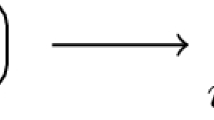Abstract
A class of P systems, called EP systems, with string objects processed by evolution rules distributed alongside the transitions of an Eilenberg machine, is introduced. A parallel variant of EP systems, called EPP systems, is also defined and the power of both EP and EPP systems is investigated in relationshipwith three parameters: number of membranes, states and set of distributed rules. It is shown that EPP systems represent a promising framework for solving NP-complete problems. In particular linear time solutions are provided for the SAT problem.
Access this chapter
Tax calculation will be finalised at checkout
Purchases are for personal use only
Preview
Unable to display preview. Download preview PDF.
Similar content being viewed by others
References
T. Bălănescu, T. Cowling, H. Georgescu, M. Gheorghe, M. Holcombe, C. Vertan, Communicating stream X-machines systems are no more than X-machines, J. Universal Comp. Sci., 5, 9 (1999), 494–507.
C. Calude, Gh. Păun, Computing with Cells and Atoms, Taylor and Francis, London, 2000.
E. Csuhaj-Varju, J. Dassow, J. Kelemen, Gh. Păun, Grammar Systems. A Grammatical Approach to Distribution and Cooperation, Gordon & Breach, London, 1994.
J. Dassow, Gh. Păun, Regulated Rewriting in Formal Language Theory, Springer Verlag, Berlin, 1989.
S. Eilenberg, Automata, Languages and Machines, Academic Press, 1974.
C. Ferretti, G. Mauri, Gh. Păun, C. Zandron, On Three Variants of Rewriting P Systems, Pre-proceedings of Workshop on Membrane Computing (WMCCdeA2001), (C. Martin-Vide, Gh. Păun, eds), Curtea de Argeş, Romania, August 2001, 63–76, and Theor. Comp. Sci., to appear.
R. Freund, Gh. Păun, On the number of non-terminals in graph-controlled, programmed, and matrix grammars, Proc. Conf. Universal Machines and Computations, Chisinau, 2001 (M. Margenstern and Y. Rogozhin, eds.), Springer-Verlag, Berlin, 2001.
M. Gheorghe, Generalised stream X-machines and cooperating grammar systems, Formal Aspects of Computing, 12 (2000), 459–472.
M. Gheorghe, M. Holcombe, P. Kefalas, Computational models of collective foraging, BioSystems, 61 (2001), 133–141.
M. Holcombe, X-machines as a basis for dynamic system specification, Software Engineering Journal, 3, 2 (1988), 69–76.
M. Holcombe, Computational models of cells and tissues: Machines, agents and fungal infection, Briefings in Bioinformatics, 2 (2001), 271–278.
M. Holcombe, What are X-machines, Formal Aspects of Computing, 12 (2000), 418–422.
M. Holcombe, F. Ipate, Correct Systems Building a Business Process Solution, Springer, Applied Computing Series, 1998.
K. Jensen, Coloured Petri Nets-Basic Concepts, Analysis Methods and Practical Use, vol 1–3, Springer, Berlin, 1992, 1994, 1997.
S. Ji, The Bhopalator, An information/energy dual model of the living cell, Preproceedings of Workshop on Membrane Computing (WMC-CdeA2001) (C. Martin-Vide, Gh. Păun, eds), Curtea de Argeş, Romania, August 2001, 123–141, and Fundamenta Informaticae, 49 (2002), 147–165.
P. Kefalas, Formal modelling of reactive agents as an aggregation of simple behaviours, LNAI 2308 (I.P. Vlahavas, C.D. Syropoulos, eds.), Springer, 461–472, 2002.
Z. Kohavi, Switching and Finite Automata Theory, McGraw-Hill, 1978.
S.N. Krishna, R. Rama, On the power of P systems with sequential and parallel rewriting, Intern. J. Computer Math., 77, 1–2 (2000), 1–14.
S.N. Krishna, R. Rama, P systems with replicated rewriting, Journal of Automata, Languages and Combinatorics, 6 (2001), 345–350.
A. Păun, P systems with string objects: Universality results, Pre-proceedings of Workshop on Membrane Computing (WMC-CdeA2001) (C. Martin-Vide, Gh. Păun, eds), Curtea de Arges, Romania, August 2001, 229–241.
Gh. Păun, Computing with membranes, Journal of Computer System Sciences, 61, 1 (2000), 108–143 (see also Turku Center for Computer Science, TUCS Report No 208, 1998, http://www.tucs).
Gh. Păun, Membrane Computing. An Introduction, Springer, Berlin, 2002.
Author information
Authors and Affiliations
Editor information
Editors and Affiliations
Rights and permissions
Copyright information
© 2003 Springer-Verlag Berlin Heidelberg
About this paper
Cite this paper
BĂlĂnescu, T., Gheorghe, M., Holcombe, M., Ipate, F. (2003). Eilenberg P Systems. In: PĂun, G., Rozenberg, G., Salomaa, A., Zandron, C. (eds) Membrane Computing. WMC 2002. Lecture Notes in Computer Science, vol 2597. Springer, Berlin, Heidelberg. https://doi.org/10.1007/3-540-36490-0_4
Download citation
DOI: https://doi.org/10.1007/3-540-36490-0_4
Published:
Publisher Name: Springer, Berlin, Heidelberg
Print ISBN: 978-3-540-00611-4
Online ISBN: 978-3-540-36490-0
eBook Packages: Springer Book Archive




